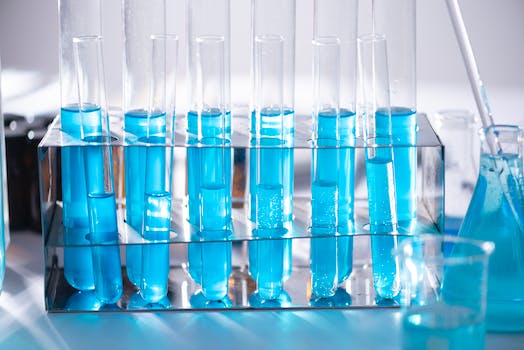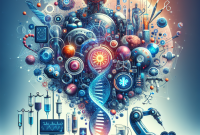
Biotechnology Breakthroughs: Gene Editing, CRISPR, and Medical Advances
-
Table of Contents
- Introduction
- Exploring the Potential of CRISPR: How Gene Editing Could Revolutionize Biotechnology
- The Latest Breakthroughs in Biotechnology: How Scientists are Using CRISPR to Treat Disease
- The Impact of Gene Editing on Human Health: What We Know So Far
- Exploring the Benefits of Biotechnology: How Medical Advances are Improving Lives
- The Future of Biotechnology: What We Can Expect from Gene Editing and CRISPR in the Coming Years
- Q&A
- Conclusion
“Unlocking the Future of Medicine: Biotechnology Breakthroughs for a Healthier Tomorrow.”
Introduction
Biotechnology has revolutionized the way we think about medicine and healthcare. In recent years, breakthroughs in gene editing, CRISPR, and medical advances have opened up a world of possibilities for treating and curing diseases. Gene editing, CRISPR, and medical advances have the potential to revolutionize the way we diagnose and treat diseases, as well as create new treatments for previously untreatable conditions. These breakthroughs have the potential to save lives and improve the quality of life for millions of people around the world. In this article, we will explore the potential of these breakthroughs and how they can be used to improve healthcare.
Exploring the Potential of CRISPR: How Gene Editing Could Revolutionize Biotechnology
The potential of CRISPR (Clustered Regularly Interspaced Short Palindromic Repeats) gene editing technology is immense. This revolutionary technology has the potential to revolutionize biotechnology and has already been used to make groundbreaking advances in the fields of medicine, agriculture, and more.
CRISPR is a gene-editing tool that allows scientists to make precise changes to the DNA of living organisms. It works by using a combination of enzymes and a guide RNA molecule to target and cut specific sections of DNA. This allows scientists to make precise changes to the genetic code of an organism, such as adding or deleting genes.
The potential applications of CRISPR are vast. In medicine, it could be used to treat genetic diseases by editing out the faulty genes that cause them. In agriculture, it could be used to create crops that are more resistant to disease and pests, or to increase crop yields. It could also be used to create new species of animals and plants, or to modify existing species to make them more useful to humans.
CRISPR has already been used to make some remarkable advances in biotechnology. For example, it has been used to create a strain of mosquitoes that are resistant to malaria, and to create a strain of wheat that is resistant to drought. It has also been used to create a strain of pigs that are resistant to a virus that causes a deadly form of diarrhea in humans.
The potential of CRISPR is truly remarkable, and it is only just beginning to be explored. As scientists continue to refine and improve the technology, it could revolutionize biotechnology and lead to a wide range of new applications. It could even be used to create entirely new species of animals and plants, or to modify existing species to make them more useful to humans. The possibilities are truly endless.
The Latest Breakthroughs in Biotechnology: How Scientists are Using CRISPR to Treat Disease
Biotechnology has made incredible advances in recent years, and one of the most exciting breakthroughs is the use of CRISPR technology to treat disease. CRISPR (Clustered Regularly Interspaced Short Palindromic Repeats) is a gene-editing tool that has revolutionized the field of biotechnology. It has enabled scientists to make precise changes to the genetic code of living organisms, including humans.
CRISPR works by using a combination of enzymes and guide RNA molecules to target and edit specific sections of DNA. This technology has been used to treat a variety of diseases, including cancer, cystic fibrosis, and sickle cell anemia. In some cases, CRISPR has been used to correct genetic mutations that cause disease. In other cases, it has been used to introduce new genes that can help fight disease.
One of the most promising applications of CRISPR is its use in gene therapy. In gene therapy, scientists use CRISPR to introduce healthy genes into cells that are affected by a genetic disorder. This can help to correct the genetic defect and restore normal function. For example, CRISPR has been used to treat a form of inherited blindness caused by a mutation in a gene called RPE65. By introducing a healthy version of the gene, scientists were able to restore vision in some patients.
CRISPR has also been used to treat cancer. In some cases, scientists have used CRISPR to edit the genes of cancer cells, making them more vulnerable to treatments like chemotherapy and radiation. In other cases, CRISPR has been used to introduce genes that can help the body fight cancer. For example, scientists have used CRISPR to introduce a gene that helps the immune system recognize and attack cancer cells.
CRISPR technology is still in its early stages, but it has already shown great promise in treating a variety of diseases. As scientists continue to refine and improve this technology, it is likely that it will become an even more powerful tool for fighting disease.
The Impact of Gene Editing on Human Health: What We Know So Far

Gene editing is a revolutionary technology that has the potential to revolutionize human health. It is a powerful tool that can be used to modify the genetic code of living organisms, including humans. This technology has the potential to treat and even cure a wide range of diseases, from cancer to genetic disorders.
In recent years, gene editing has become increasingly popular and is being used in a variety of ways. It is being used to create new treatments for diseases, to improve crop yields, and even to create new species of animals. However, the most exciting potential of gene editing is its ability to treat and even cure genetic diseases.
Gene editing works by using a technique called CRISPR-Cas9. This technique allows scientists to make precise changes to the genetic code of a living organism. By making these changes, scientists can alter the expression of certain genes, which can lead to the development of new treatments for diseases.
So far, gene editing has been used to treat a variety of diseases, including cancer, HIV, and cystic fibrosis. In addition, gene editing has been used to create new treatments for genetic disorders, such as Huntington’s disease and sickle cell anemia.
Gene editing also has the potential to be used to create new treatments for a variety of other diseases. For example, scientists are currently exploring the possibility of using gene editing to create treatments for Alzheimer’s disease, Parkinson’s disease, and even autism.
While gene editing has the potential to revolutionize human health, there are still many unknowns. For example, scientists are still trying to understand the long-term effects of gene editing on human health. In addition, there are ethical and safety concerns that need to be addressed before gene editing can be used on humans.
Despite these unknowns, gene editing has already had a significant impact on human health. It has the potential to revolutionize the way we treat and even cure a variety of diseases. As scientists continue to explore the potential of gene editing, we can expect to see even more exciting developments in the future.
Exploring the Benefits of Biotechnology: How Medical Advances are Improving Lives
Biotechnology has revolutionized the medical field, providing new treatments and therapies that are improving the lives of countless individuals. From gene therapy to stem cell research, biotechnology is helping to develop treatments for a wide range of diseases and conditions. In this blog post, we’ll explore some of the ways biotechnology is making a difference in the lives of patients.
Gene Therapy
Gene therapy is a type of biotechnology that involves introducing genetic material into cells to treat or prevent disease. This technique has been used to treat a variety of conditions, including cancer, cystic fibrosis, and hemophilia. In some cases, gene therapy can even be used to correct genetic defects that cause disease.
Stem Cell Research
Stem cell research is another area of biotechnology that is making a difference in the lives of patients. Stem cells are cells that can develop into any type of cell in the body, and they can be used to treat a variety of diseases and conditions. For example, stem cells can be used to repair damaged tissue, such as in the case of spinal cord injuries. They can also be used to treat diseases such as diabetes and Parkinson’s.
Organ Transplants
Organ transplants are another area of biotechnology that is improving the lives of patients. Organ transplants are used to replace organs that are damaged or diseased. This can be a life-saving procedure for those who are suffering from organ failure.
Gene Editing
Gene editing is a type of biotechnology that involves altering the genetic code of an organism. This technique has been used to treat a variety of diseases, including cancer and cystic fibrosis. It can also be used to create new treatments for diseases that have no existing treatments.
These are just a few of the ways biotechnology is making a difference in the lives of patients. From gene therapy to stem cell research, biotechnology is providing new treatments and therapies that are improving the lives of countless individuals. As biotechnology continues to advance, we can expect to see even more medical advances that will improve the lives of patients.
The Future of Biotechnology: What We Can Expect from Gene Editing and CRISPR in the Coming Years
Biotechnology is a rapidly evolving field that has the potential to revolutionize the way we live. In recent years, gene editing and CRISPR technology have emerged as powerful tools for manipulating genetic material. These technologies have already been used to create new treatments for diseases, develop crops with improved yields, and even create new species of organisms. As these technologies continue to advance, they will open up a world of possibilities for the future of biotechnology.
One of the most exciting applications of gene editing and CRISPR technology is the potential to create personalized treatments for diseases. By using gene editing to modify a patient’s own cells, doctors could potentially create treatments that are tailored to the individual’s genetic makeup. This could lead to more effective treatments for a wide range of diseases, from cancer to genetic disorders.
Another potential application of gene editing and CRISPR technology is the development of new crops with improved yields. By manipulating the genetic material of plants, scientists could create crops that are more resistant to disease, require less water, and produce higher yields. This could have a huge impact on global food security, as it would allow farmers to produce more food with fewer resources.
Finally, gene editing and CRISPR technology could be used to create entirely new species of organisms. By manipulating the genetic material of existing organisms, scientists could create organisms with entirely new traits and abilities. This could lead to the development of new medicines, materials, and even organisms that could be used to clean up environmental pollutants.
As gene editing and CRISPR technology continue to advance, the possibilities for the future of biotechnology are virtually limitless. In the coming years, we can expect to see these technologies used to create personalized treatments for diseases, develop new crops with improved yields, and even create entirely new species of organisms. The future of biotechnology is an exciting one, and it’s only just beginning.
Q&A
Q1: What is gene editing?
A1: Gene editing is a technology that allows scientists to make precise changes to an organism’s DNA. It can be used to add, remove, or modify specific genes in order to alter the organism’s characteristics.
Q2: What is CRISPR?
A2: CRISPR (Clustered Regularly Interspaced Short Palindromic Repeats) is a gene-editing technology that uses a specific enzyme to cut and paste DNA. It is a powerful tool for making precise changes to an organism’s genetic code.
Q3: How is gene editing being used in medical advances?
A3: Gene editing is being used to develop treatments for a variety of diseases, including cancer, HIV, and genetic disorders. It is also being used to create new medicines and vaccines.
Q4: What are the potential risks of gene editing?
A4: The potential risks of gene editing include unintended changes to the genetic code, the creation of new diseases, and the potential for misuse of the technology.
Q5: What are the ethical considerations of gene editing?
A5: Ethical considerations of gene editing include the potential for misuse of the technology, the potential for unintended consequences, and the potential for creating new forms of inequality.
Conclusion
Biotechnology breakthroughs such as gene editing, CRISPR, and medical advances have the potential to revolutionize the way we treat and prevent diseases. These technologies have already made great strides in the medical field, and their potential for further advancement is immense. With continued research and development, these technologies could lead to treatments and cures for a wide range of diseases and conditions. As we continue to explore the possibilities of biotechnology, we can look forward to a future of improved health and well-being for all.






